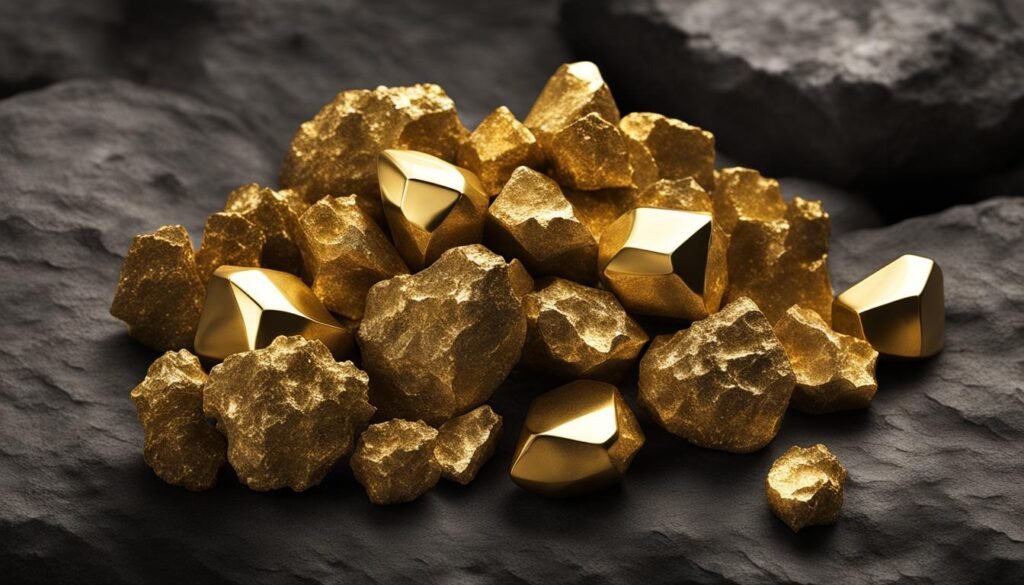Discover Why Gold is an Element: Essential Information for You
Gold is an element with a rich history and significant value. It is a chemical element with the symbol Au and atomic number 79. Its name, derived from the Latin word Aurum, meaning shining dawn, reflects its radiant and precious qualities. Gold is naturally occurring and abundant in the Earth’s crust, with a concentration of 0.004 parts per million (ppm). It is one of the three elements known to ancient civilizations and has been used as primitive money. Gold’s physical properties, such as its malleability and density, make it highly versatile and useful in various applications.
Gold plays a significant role in everyday life, from its use in jewelry and decorative objects to its industrial applications in electronics and dentistry. Although no longer the basis for the international monetary system, gold remains a highly regarded reserve asset. In this article, we will explore the history, physical properties, cultural significance, and global production of gold, providing you with essential information about this fascinating element.
Key Takeaways:
- Gold is a chemical element with the symbol Au and atomic number 79.
- It is abundant in the Earth’s crust, naturally occurring, and one of the three elements known to ancient civilizations.
- Gold is highly malleable, dense, and has excellent conductivity.
- It is used in various applications, including jewelry, electronics, and dentistry.
- While no longer the basis for the international monetary system, gold remains a highly regarded reserve asset.
The History and Origins of Gold
Gold has a rich history and has been highly valued since ancient times. The name gold has Anglo Saxon roots but originated from the Latin word Aurum and has its roots in Greek. Gold, along with silver and copper, forms a column in the periodic table and was one of the first three elements known to man.
It was used as primitive money even before the first gold coins were minted in Egypt around 3400 BC. The majority of gold found today is ancient or comes from Central American civilizations like the Aztecs and Incas, which were brought to Europe by the Spanish and Portuguese in the 16th century. Since then, it has been recycled multiple times.
In the 19th century, significant gold discoveries were made in regions such as Siberia, California, Australia, South Africa, and Alaska, leading to gold rushes and increased production. Today, around 2300 tons of gold are produced annually.

The Physical Properties of Gold
Gold possesses unique physical properties that contribute to its versatility and desirability. Understanding these properties can shed light on why gold is widely used in various applications.
1. Density of Gold
Gold is known for its exceptional density. At 20°C, gold has a specific gravity of 19.3, making it one of the densest metals. This high density is why gold is often used as a benchmark for measuring the density of other materials. Its density plays a crucial role in its applications, such as in the accurate calibration of precision instruments.
2. Conductivity of Gold
Gold is an excellent conductor of heat and electricity. It has the highest electrical conductivity of all metals, making it an ideal material for various electronic components, such as connectors and switches. Gold’s exceptional conductivity ensures efficient transmission of signals and minimizes energy loss.
3. Malleability and Ductility of Gold
Gold is highly malleable and ductile, meaning it can be easily shaped into various forms, such as thin sheets or wires, without breaking. In fact, gold is so malleable that just one ounce (31.1 grams) can be beaten into a sheet measuring 187 square feet (about 17 square meters). Its ductility allows for the production of fine wires, with just one gram of gold capable of being drawn into 165 meters of wire 20 microns thick. These properties make gold ideal for intricate jewelry designs and specialized industrial applications.
The physical properties of gold contribute to its exceptional value and its ability to fulfill a wide range of uses. Its high density, conductivity, malleability, and ductility make it a versatile and desirable material in various industries.
| Physical Property | Description |
|---|---|
| Density | Gold has a specific gravity of 19.3, making it one of the densest metals. |
| Conductivity | Gold is an excellent conductor of heat and electricity, making it valuable in electronics and other applications. |
| Malleability and Ductility | Gold can be easily shaped into thin sheets or drawn into fine wires without breaking, allowing for various uses in jewelry and industrial applications. |
“Gold’s density, conductivity, and malleability make it an exceptional material for a wide range of applications.”

Despite its relatively high cost, gold’s physical properties make it a sought-after material in industries such as electronics, jewelry-making, and dentistry. The combination of density, conductivity, and malleability sets gold apart from other metals and contributes to its enduring appeal.
Gold in Art and Jewelry
Gold has long been admired and cherished for its beauty and allure, making it a popular material in the world of art and jewelry. Its lustrous and radiant appearance, coupled with its malleability and resistance to tarnish, has made gold a coveted medium for creating masterpieces that stand the test of time.
In the realm of art, gold has been used by civilizations across the globe to create intricate and captivating artifacts. Ancient Egyptian, Minoan, Assyrian, and Etruscan cultures are just a few examples of civilizations that showcased elaborate gold craftsmanship in their artifacts. These ancient artists used gold to depict deities, royalty, and significant events, infusing their creations with a sense of grandeur and luxury.
“Gold has a magical power to captivate the eye and stir the soul.” – Ansel Adams
Gold’s timeless appeal extends to the world of jewelry, where it is highly sought after for its durability and ability to retain its value. Gold is often used in the creation of exquisite pieces, ranging from delicate necklaces and earrings to statement rings and bracelets. Its versatility allows for a wide range of designs, from classic and elegant to bold and contemporary, catering to diverse preferences and styles.
| Jewelry Type | Description |
|---|---|
| Gold Necklaces | Elevate your neckline with a stunning gold necklace, available in a variety of styles and lengths to suit your personal taste. |
| Gold Earrings | Adorn your ears with the timeless elegance of gold earrings, available in studs, hoops, chandeliers, and more. |
| Gold Rings | Make a statement with a gold ring, featuring intricate designs, gemstones, and personalized engravings. |
| Gold Bracelets | Add a touch of sophistication to your wrist with a gold bracelet, available in various styles, including bangles, chains, and cuffs. |
Gold leaf, a thin sheet of gold, is another fascinating aspect of gold’s use in art and jewelry. It has been utilized for centuries to embellish religious and artistic objects, adding a touch of opulence and brilliance. Gold leaf is carefully applied to surfaces, creating a shimmering effect that catches the light and enhances the overall visual impact of the artwork or jewelry piece.

From ancient civilizations to modern-day artisans, gold continues to captivate and inspire creativity. Its timeless allure and enduring value make it a cherished medium in the world of art and jewelry, ensuring its place in the hearts of admirers for generations to come.
Gold’s Role in Currency and Financial Systems
Gold has played a significant role in currency and financial systems throughout history. It has been used as a high-denomination currency and served as a means of exchange when silver was the standard medium of payments. The use of gold as backing for paper currency systems became widespread in the 19th century, and the gold standard was the basis for world currencies until World War I. While its official role in the international monetary system has diminished, gold remains a highly regarded reserve asset.
Governments and central banks hold approximately 45% of the world’s gold for this purpose. Gold’s intrinsic value and limited supply make it a trusted store of wealth and a means of diversifying financial reserves. It provides stability and acts as a hedge against inflation and currency fluctuations. The significance of gold as a reserve asset has been reaffirmed in recent times, particularly during times of economic uncertainty and market volatility.
Gold is universally accepted as a medium of international payment by all nations. Its liquidity and recognizable value make it a reliable form of currency, especially in times of financial crisis. Gold’s historical role as a currency and its continued use as a reserve asset reflect its enduring appeal and relevance in the modern financial landscape.
Gold’s Role in Currency Reserves
Central banks and governments hold gold as part of their foreign exchange reserves to provide stability, backing, and confidence in their currencies. These reserves act as a safeguard against economic and geopolitical risks, ensuring a country’s ability to meet its financial obligations and maintain the value of its currency. The size of a nation’s gold reserves can impact its creditworthiness and financial standing in the global economy. Gold holdings are also a reflection of a country’s economic strength and its ability to weather economic downturns.
| Country | Gold Reserves (in metric tons) |
|---|---|
| United States | 8,133.5 |
| Germany | 3,362.4 |
| Italy | 2,451.8 |
| France | 2,436.0 |
| Russia | 2,299.9 |
Table: Top 5 Countries with the Largest Gold Reserves (as of 2021)
The countries with the largest gold reserves have a considerable influence on global financial markets and can play a crucial role in shaping international monetary policies. Gold holdings provide stability and act as a buffer against market uncertainties, reinforcing confidence in the global financial system. The strategic accumulation and management of gold reserves are vital for countries to protect their economies and maintain financial stability.
Gold’s role in currency and financial systems extends beyond mere monetary value. It retains a sense of cultural and historical significance and remains synonymous with wealth and prosperity. The allure of gold as a store of value and medium of exchange has endured for centuries, making it an integral part of the global financial order.
Gold Standard and Economic Stability
The gold standard, which tied the value of currency to a fixed amount of gold, played a crucial role in maintaining economic stability and controlling inflation. Under the gold standard, countries had to hold a sufficient amount of gold reserves to back their currency, ensuring its convertibility into gold at a fixed price. This system provided a stable framework for international trade and investment and promoted confidence in the value of money.
Gold standard: “The gold standard is one of the most important monetary systems in history. It provided stability, limited government manipulation of currency, and facilitated international trade. While it is no longer in practice, its influence and legacy continue to shape monetary and economic policies today.”
However, the gold standard had its limitations. It constrained the ability of central banks to implement monetary policies during economic crises, as they were required to maintain a fixed exchange rate with gold. This lack of flexibility made it difficult to address economic downturns and stimulate growth. As a result, the gold standard was abandoned during the 20th century in favor of more flexible exchange rate systems.
While the gold standard is no longer in practice, gold’s role as a reserve asset and its historical significance in currency systems have left a lasting impact. It continues to serve as a benchmark for evaluating the stability and credibility of currencies and financial systems worldwide.
Gold Production and Mining
Gold production is a fascinating process that involves the extraction of gold from various types of deposits. There are two main types of gold-bearing deposits: hydrothermal veins and placer deposits.
Hydrothermal veins are formed when gold is carried up from great depths in an aqueous solution and later precipitated. These veins are usually found in areas of intense volcanic activity and can contain high concentrations of gold. Placer deposits, on the other hand, are derived from the weathering of gold-bearing rocks. Over time, the gold is eroded and transported by water, eventually settling in riverbeds and other sedimentary environments.
The history of gold production is punctuated by significant events such as the California gold rush in the mid-1800s and the discoveries in Alaska, South Africa, and Australia. These gold rushes led to a surge in gold production and played a crucial role in shaping the economies and societies of these regions. Today, major gold producers include South Africa, Russia, the United States, Australia, and China.
| Country | Gold Production (metric tons) |
|---|---|
| South Africa | 120 |
| Russia | 100 |
| United States | 80 |
| Australia | 70 |
| China | 60 |
Gold mining is a complex and labor-intensive process that requires the use of heavy machinery and specialized techniques. It involves the excavation and removal of gold-bearing ore from the earth, which is then processed to extract the gold. This process can have significant environmental impacts, such as habitat destruction and pollution of water bodies. However, efforts are being made to promote sustainable mining practices and minimize these impacts.

Historical Gold Rushes
One of the most famous gold rushes in history was the California gold rush of 1848. Following the discovery of gold at Sutter’s Mill, thousands of people flocked to California in search of fortune. This event had a profound impact on the region, leading to the rapid growth of cities such as San Francisco and the influx of settlers from around the world.
“There’s gold in them hills!” – Unknown prospector
Other notable gold rushes include the Klondike gold rush in Yukon, Canada, in the late 1890s, and the Witwatersrand gold rush in South Africa in the late 1800s. These gold rushes attracted prospectors from all walks of life and played a crucial role in the development of these regions.
In conclusion, gold production and mining have shaped the course of history and continue to be important industries worldwide. The quest for gold has led to significant discoveries, economic transformations, and cultural shifts. As we move forward, it is essential to balance the economic benefits of gold production with the need for responsible environmental stewardship.
Gold Alloys and Industrial Applications
Gold, in its pure form, is too soft for many practical applications. To enhance its hardness and durability, gold is often alloyed with other metals. These gold alloys find a wide range of industrial uses, from jewelry production to electronics and dentistry.
In the jewelry industry, gold alloys are commonly used to create different shades and strengthen the metal. Most gold jewelry contains a blend of gold, silver, copper, and zinc. The proportions of these metals determine the color of the alloy, whether it’s yellow, rose, or white gold. For instance, white gold is created by adding nickel or palladium to the gold-silver-copper mixture.
| Industrial Application | Gold Alloy |
|---|---|
| Jewelry | A blend of gold, silver, copper, and zinc |
| Electronics | Gold plating on contacts, terminals, and printed circuits for its high electrical conductivity and resistance to corrosion |
| Dentistry | A blend of gold, silver, and other metals for dental fillings and crowns |
Gold’s excellent electrical conductivity and resistance to corrosion make it valuable in the electronics industry. Thin layers of gold are applied through a process called gold plating on contacts, terminals, and printed circuits. Gold plating ensures reliable electrical connections and prevents oxidation of the underlying materials.
In dentistry, gold alloys are used for dental fillings and crowns due to their biocompatibility, durability, and resistance to corrosion. Gold fillings offer longevity and provide an excellent option for patients with metal allergies or sensitivity to other dental materials.
Overall, gold alloys have a wide range of industrial applications, thanks to their unique properties. From the beauty of gold jewelry to the functionality of gold-plated electronics and dental restorations, gold continues to play a significant role in various industries.
Gold’s Chemical Properties
Gold, with its noble characteristics, displays limited chemical reactivity. It resists attack by oxygen and sulfur, but can react with halogens and chlorine-containing solutions such as aqua regia. Gold can also dissolve in cyanide solutions, forming the stable dicyanoaurate ion.
Gold compounds, including gold chloride and chlorauric acid, have industrial applications. Potassium cyanoaurate is commonly used in gold-plating baths. Gold exhibits oxidation states of +1 (aurous compounds) and +3 (auric compounds). The +3 state is more prevalent and involved in the electrolytic refining of gold.
“Gold’s unique chemistry makes it suitable for various applications, ranging from decorative use to industrial processes.”
Gold plating is a common application in which a thin layer of gold is deposited onto a surface to enhance its appearance or protect it from corrosion. Gold-plated jewelry, medals, and electronic connectors are examples of such applications.
The electroplating process uses an electrolytic solution containing a gold salt, an anode made of pure gold, and a cathode to which the item to be plated is connected. Through electrolysis, gold ions are reduced at the cathode, forming a thin layer of gold on the surface.
Gold Plating Process
| Step | Description |
|---|---|
| Preparation | The item to be plated is thoroughly cleaned and prepared to ensure proper adhesion of the gold layer. |
| Electrolyte Preparation | An electrolytic solution containing a gold salt is prepared, ensuring the appropriate concentration and pH level. |
| Plating Process | The item is connected to the cathode and immersed in the electrolyte solution. A direct current is applied, causing gold ions to be reduced and deposited onto the surface of the item. |
| Rinsing and Drying | After the desired thickness of gold plating is achieved, the item is rinsed to remove any excess electrolyte and dried. |
Gold’s ability to be easily manipulated through chemical processes makes it a highly valuable element in the field of metallurgy and various industrial applications. Its resistance to tarnish and its attractive appearance also contribute to its widespread use in jewelry and decorative objects.
Gold’s Historical Significance and Cultural Impact
Gold has a rich historical value and has had a profound impact on civilizations throughout the ages. From ancient times to the present day, gold has been treasured for its beauty, rarity, and intrinsic value. The discovery of gold has sparked significant cultural shifts and economic booms, shaping the course of human history.
In ancient civilizations, gold held immense symbolic value. It was often associated with power, wealth, and the divine. The Egyptians, for example, believed that gold was the flesh of the gods and used it to adorn their statues and temples.
In Mesopotamia, gold was a symbol of kingship, with rulers wearing elaborate gold jewelry to signify their authority. The discovery and acquisition of gold played a crucial role in the rise and fall of empires, as seen in the conquests of the Spanish conquistadors in the Americas.
“Gold has the power to inspire, to corrupt, and to endure.”
Gold rushes, such as the California Gold Rush in the 19th century, brought thousands of people from all over the world in search of fortune. These rushes led to the rapid development of previously desolate areas, creating bustling cities and leaving lasting impacts on the culture and economy of the regions. The allure of gold continues to captivate people’s imaginations, inspiring stories, songs, and legends.
The Impact of Gold Discoveries
The discovery of new gold deposits has had a profound impact on societies and economies. Gold rushes have transformed remote locations into thriving communities, bringing wealth, opportunity, and innovation. The influx of people and capital has stimulated infrastructure development, including the construction of roads, railways, and buildings.
Moreover, gold has played a crucial role in shaping economic systems. It has been used as a medium of exchange, a store of value, and a measure of wealth. The gold standard, where currencies were tied to the value of gold, influenced global financial systems for centuries. Today, gold continues to serve as a reserve asset held by central banks, ensuring stability and confidence in the global economy.
Gold’s historical significance and cultural impact are testament to its enduring allure and universal appeal. Its value extends beyond its physical properties, transcending time and borders. From ancient civilizations to modern societies, gold continues to captivate and inspire, leaving an indelible mark on our collective consciousness.

Table: Historical Gold Discoveries
| Gold Discovery | Year | Location |
|---|---|---|
| California Gold Rush | 1848 | California, United States |
| Klondike Gold Rush | 1896 | Yukon, Canada |
| Witwatersrand Gold Rush | 1886 | South Africa |
| Australian Gold Rush | 1851 | Australia |
| Alaska Gold Rush | 1896 | Alaska, United States |
Gold’s Global Production and Distribution
Gold production has been a dynamic industry with shifts in global distribution over time. Historically, countries such as South Africa, Russia, the United States, and Australia were the major gold producers. However, in recent years, China has emerged as the world leader in gold production. Other significant gold-producing countries include Canada and South Africa.
The global gold supply is determined by a combination of factors including geological deposits, mining technologies, and economic and political considerations. New discoveries and advancements in mining techniques have led to shifts in production. As a result, the distribution of gold production has changed over the years.
To understand the current state of gold production, it is important to analyze the data. The table below showcases the top gold-producing countries and their respective production volumes for the year 2020.
Gold as a Limited Resource and Environmental Considerations
Gold, despite its widespread use and cultural significance, is a limited resource that is subject to geological constraints and economic viability. The extraction and refinement process of gold mining can have significant environmental impacts, raising concerns about sustainability and responsible practices.
One of the primary environmental concerns related to gold mining is habitat destruction. The extraction of gold often involves clearing large areas of land, which can disrupt ecosystems and lead to the loss of biodiversity. Additionally, the use of heavy machinery and blasting techniques can cause soil erosion and contribute to the pollution of nearby water bodies.
Another environmental issue associated with gold mining is the release of toxic substances. The use of cyanide in the gold extraction process, particularly in large-scale mining operations, can lead to the contamination of soil and water sources. These toxic substances can have detrimental effects on local ecosystems and pose risks to human health.
Environmental Impact of Gold Mining:
Gold mining also consumes significant amounts of water, which can strain local water resources, especially in areas where water scarcity is already a concern. The high water requirements for gold mining operations can further exacerbate this issue, leading to competition for water resources between mining operations and local communities.
To mitigate these environmental impacts, sustainable mining practices have been developed, focusing on minimizing habitat destruction, reducing resource consumption, and implementing stringent waste management and pollution control measures. In addition, responsible sourcing initiatives aim to ensure that gold is obtained from mines that adhere to strict environmental and social standards.
| Environmental Impact | Description |
|---|---|
| Habitat Destruction | Clearing large areas of land for mining operations, causing the loss of biodiversity and disruption of ecosystems. |
| Water Pollution | Release of toxic substances, such as cyanide, into soil and water sources, leading to contamination and potential hazards to human health. |
| Water Consumption | Significant water usage in gold mining operations, straining local water resources and exacerbating water scarcity concerns. |
| Resource Consumption | High energy and resource requirements for the extraction and refinement process of gold mining, contributing to resource depletion. |
| Waste Management | Management of waste generated during mining operations, including proper containment and disposal methods to minimize environmental impacts. |
By implementing sustainable practices and promoting responsible mining, the gold mining industry aims to minimize its environmental footprint and ensure the long-term viability of gold as a valuable resource.

Conclusion
Gold is an extraordinary element that possesses unique properties, making it highly valued throughout history. Its abundance in the Earth’s crust, coupled with its malleability, conductivity, and resistance to tarnish, has made gold a versatile material for various applications.
Throughout time, gold has played a significant role in shaping human civilizations, influencing cultural, economic, and artistic developments. Its historical and cultural significance is undeniable, associating gold with wealth, power, and beauty. From ancient times to modern societies, gold has left an indelible mark on cultures and continues to be highly regarded.
While gold no longer serves as the basis for the international monetary system, it remains a treasured reserve asset held by governments and central banks. Its limited availability reinforces its value and emphasizes the importance of responsible mining practices to ensure sustainable use and mitigate environmental impacts.
In conclusion, gold’s elemental properties, historical significance, and cultural impact make it a remarkable asset. As we move forward, it is crucial to preserve and appreciate the unique qualities of gold while promoting responsible practices that safeguard our environment and support the sustainable utilization of this precious metal.
FAQ about Gold is an Element
What is the chemical symbol and atomic number of gold?
The chemical symbol of gold is Au, and its atomic number is 79.
Where does the name “gold” come from?
The name “gold” comes from the Latin word Aurum, meaning shining dawn.
How abundant is gold in the Earth’s crust?
Gold is found in the Earth’s crust with a concentration of 0.004 parts per million (ppm).
What is the most common isotope of gold?
The most common isotope of gold is Au-197.
What are some historical uses of gold?
Gold has been used as primitive money and has played a significant role in currency and financial systems throughout history.
How is gold used in modern times?
Gold is used in jewelry, decorative objects, electronics, dentistry, and as a reserve asset held by governments and central banks.
How is gold produced?
Gold is found in hydrothermal veins and placer deposits, and major gold producers include South Africa, Russia, the United States, Australia, and China.
What are the physical properties of gold?
Gold is dense, malleable, ductile, and an excellent conductor of heat and electricity.
What are some industrial applications of gold?
Gold is used in the electronics industry for plating contacts and terminals, and in dentistry for fillings and repairs.
How is gold used in art and jewelry?
Gold is used to craft jewelry, decorative objects, gold coins, and goldware. Thin sheets of gold, known as gold leaf, are used for artistic embellishments.
What is the environmental impact of gold mining?
Gold mining can have ecological consequences such as habitat destruction, soil erosion, water pollution, and the release of toxic substances. Sustainable mining practices aim to mitigate these impacts.
How has gold been culturally significant throughout history?
Gold has been treasured by civilizations worldwide and is associated with wealth, power, and beauty.
Where is gold primarily found?
Gold is widespread in low concentrations in all igneous rocks and is often found in the native state, often in association with copper and lead deposits.
Source Links
- https://www.britannica.com/science/gold-chemical-element
- https://www.rsc.org/periodic-table/element/79/gold
- https://www.britannica.com/science/gold-chemical-element/Properties-occurrences-and-uses







